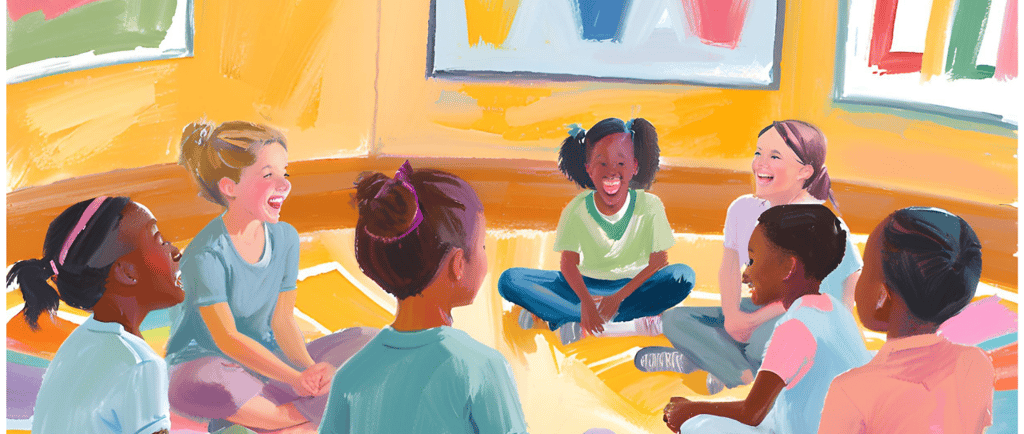Circle Time at Home: A Daily Routine That Builds Lifelong Skills
Circle time is more than a fun classroom activity—it’s a powerful tool for building social, emotional, and academic skills. This post explores how kids learn teamwork, communication, and early academics while fostering creativity and connection. Plus, discover practical tips for incorporating circle time into your homeschool routine, making it engaging and adaptable for children of all ages.
HOMESCHOOLPRESCHOOL
1/22/20254 min read


What Do Kids Learn During Circle Time?
If you’ve ever peeked into a preschool or kindergarten classroom, you’ve probably seen children sitting in a circle, singing songs, sharing ideas, or listening to a story. This magical time, known as circle time, is more than just a daily ritual—it’s a rich learning experience that sets the foundation for lifelong skills. Let’s dive into what children learn during this special part of the day and why it’s so valuable.
1. Building Social Skills
Circle time is a perfect opportunity for kids to practice social interaction in a structured, supportive environment. They learn how to:
Take Turns: Waiting for their turn to speak or participate teaches patience.
Listen Actively: Focusing on others during discussions fosters mutual respect.
Cooperate: Group activities encourage teamwork and problem-solving.
Show Respect: Kids learn to value the opinions and feelings of others.
2. Strengthening Communication
Whether they’re sharing their favorite toy, answering questions, or singing along, circle time boosts communication skills. Children develop:
Speaking Confidence: Expressing thoughts in front of a group builds self-esteem.
Vocabulary: Songs, stories, and discussions expose kids to new words.
Questioning and Answering: Practicing how to ask and respond helps with critical thinking.
Nonverbal Cues: Kids learn to interpret gestures and facial expressions, enriching their understanding of communication.
3. Encouraging Cognitive Growth
Circle time activities spark curiosity and critical thinking. It’s a time to:
Focus and Pay Attention: Structured routines help kids develop concentration.
Solve Problems: Interactive discussions or games encourage logical thinking.
Boost Memory: Recalling songs, names, or routines sharpens memory skills.
Explore New Concepts: Learning about topics like the weather, numbers, or letters helps build a foundation for academics.
4. Fostering Emotional Growth
Circle time provides a safe space for children to explore their feelings and develop emotional intelligence. They learn to:
Regulate Emotions: Managing excitement or frustration during group activities.
Empathize: Listening to classmates fosters an understanding of others’ feelings.
Build Confidence: Sharing ideas helps children feel valued and important.
5. Laying Life-skill Foundations
Many circle time activities are designed to the basics like:
Reading and Using a Calendar: Teaching days of the week, months of the year, and major holidays.
Greetings: Practicing how to greet someone, say bye, and when to ask questions.
Numbers and Letters: Reinforcing letters and their sounds as well as the numbers they are learning.
Weather Vocabulary: Learning and identifying weather types as well as seasons.
8. Inspiring Creativity
Circle time sparks imagination through:
Songs and Rhymes: Engaging in music and rhythmic activities.
Storytelling: Listening to or acting out stories encourages creative thinking.
Thematic Play: Exploring ideas tied to a theme, like seasons or animals.
How to Incorporate Circle Time into Your Homeschool
The beauty of circle time is that it’s flexible and can be adapted to fit your homeschooling routine. Here’s how you can create a meaningful and engaging circle time experience at home:
1. Set the Stage
Create a designated space for circle time in your home. It could be a cozy corner with cushions, a rug, or a spot around the dining table. The key is to make it a consistent and inviting place where everyone feels comfortable.
2. Establish a Routine
Start each day with circle time to set the tone for learning. A typical structure might include:
Greeting: Begin with a cheerful "Good morning!" song or a simple greeting.
Calendar Time: Discuss the date, day of the week, and weather. Use a visual calendar or weather chart for added engagement.
Theme Introduction: Introduce the day's or week’s theme (e.g., seasons, animals, or Bible stories).
Songs and Movement: Incorporate action songs, clapping games, or simple stretches to wake up young minds.
Storytelling: Share a story related to the theme or a favorite book.
3. Make It Interactive
Circle time works best when everyone is involved. Encourage your kids to:
Share their thoughts during discussions or storytime.
Take turns leading songs or calendar activities.
Participate in games, like matching weather cards or counting objects.
4. Use Multi-Age Activities
Since homeschooling often involves children of different ages, include activities that everyone can enjoy:
Songs and Rhymes: Younger kids can follow along with actions, while older ones practice memorization.
Thematic Discussions: Tailor questions to each child's level, encouraging deeper thinking for older kids.
Hands-On Activities: Use manipulatives like counting bears or letter tiles for interactive learning.
5. Incorporate Faith (Optional)
For faith-based homeschooling, circle time can include:
A short Bible verse or devotional.
Prayer time, where each child shares a gratitude or prayer request.
Songs of worship or praise.
6. Keep It Short and Sweet
Young children have short attention spans, so keep circle time brief—about 10-20 minutes, depending on their ages. End with a closing song or a preview of the day's activities to maintain excitement.
7. Make It Your Own
Circle time is all about fostering connection and curiosity, so don’t be afraid to personalize it:
Use Visual Aids: Posters, flashcards, and props make learning engaging.
Integrate Themes: Align circle time with your homeschool’s unit study or monthly focus.
Celebrate Milestones: Acknowledge birthdays, holidays, or special achievements during this time.
Circle time can become a treasured part of your homeschool day—a moment for everyone to come together, share, and set the stage for meaningful learning. Whether you’re discussing the weather, exploring a new topic, or singing silly songs, the connections you build during this time will leave a lasting impact.


